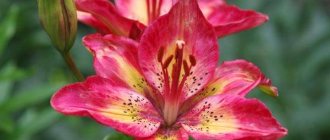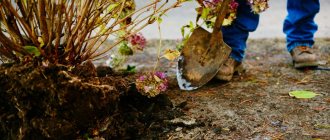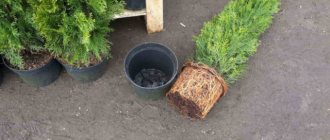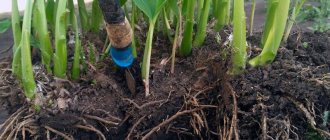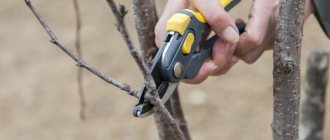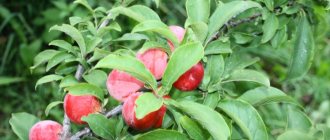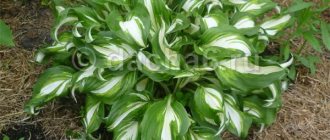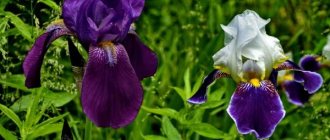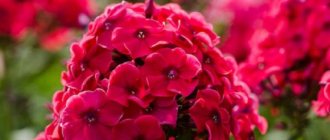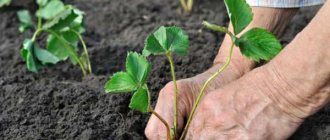How to replant a turf
Some of the most undemanding and attractive for planting in gardens, parks and dachas are various types and varieties of derain.
The most popular is white derain, or svidina, as well as an elegant form - variegated derain. These plants are the dogwood's closest relatives. White dogwood is unusually decorative even in winter, since its bark is brightly colored - from yellow to scarlet and dark burgundy. These plants tolerate even extreme conditions well and can tolerate drought, poor soil and lack of light. But they achieve their best shape and ideal coloring of leaves and shoots provided they are well cared for and correctly positioned on the site. Sometimes an incorrectly planted bush has to be replanted. It is better, of course, to do this while the plant is still young, but the turf can easily survive replanting as an adult.
In what cases may tree transplantation be necessary?
You need to understand that replanting an adult plant is a serious stress for it, no matter how carefully it is done. Therefore, such a procedure is performed only as a last resort, when there are simply no other options left.
Wrong location. If the plant was planted in the wrong place, for example, a variegated turf was in the shade, then it will quickly lose the beauty of its decorative leaves, turning into the usual green color. To return the bush to its beauty and decorativeness, it will have to be moved to a sunny place.
Unsuitable soils. All types of pigweed are demanding on the quality of the soil, but they reach the full flowering of their beauty only on fertile soils with sufficient and regular moisture. If the turf withers on skinny, dry soil, the only way to save it is to transplant it to another place with high-quality nutrient soil.
Poor choice of site. A very overgrown turf in a cramped area can begin to “crowd” its more delicate neighbors. The choice remains - remove the surroundings and leave one turf, or transplant this plant to a more suitable open place. In most cases, tree transplantation is more convenient and profitable.
Choosing a new landing site
In order for a plant to successfully take root in a new place, it must be carefully selected and prepared. If we are talking about a variegated tree, the new place must be sunny. A sunny location is also preferable for white dogwood, but this plant is also tolerant of partial shade or an area that is shaded for some part of the day.
It is advisable to choose soils for pigweed that are nutritious and sufficiently moist, or to provide the plant with proper care. If we are talking about replanting an entire hedge, you should make sure that it takes root well in its new location. To do this, a trench for replanting is dug in advance, one and a half to two times larger than the estimated root system of the transplanted plants. The ditch is deepened, a layer of fresh fertile soil mixed with well-rotted humus, decomposed compost and long-term mineral fertilizers is poured onto its bottom. For individual tree bushes being transplanted, the pit is prepared in exactly the same way, only round in shape.
Derain tolerates pruning well; this procedure is even necessary for this plant, since only young stems have a bright, attractive color. To stimulate their growth, the dena bush is completely cut off almost at ground level every three to four years. This can be used to transplant to a new location.
Plants can be replanted late in the fall, when the leaves have fallen, or early in the spring, before the buds begin to swell. Each method of transplanting turf to a new location has its own advantages and disadvantages. When planted in spring, the plant quickly begins to grow, but the gardener has a greater chance of “growing” the plant by constantly being on the site or dacha. Autumn replanting is less stressful and gives the plant more time to acclimatize.
It is always advisable to replant an adult plant with an intact ball of soil. To do this, the plant is carefully dug out along the contours of the crown. The projection of the crown of the tree onto the ground shows the approximate boundary of the plant's root system. By working according to this scheme, you can preserve as many healthy roots as possible. Digging is carried out gradually, trying to separate the bush from the main mass of the earth in a circle. Then the dug up plant is placed on matting or film, the root system is wrapped in it along with a lump of earth, tied up and delivered to the planting site in a wheelbarrow.
The pit for replanting must be prepared in advance. The main success of the operation is to keep the roots of the plant from drying out. Svidina will also tolerate transplantation with bare roots; it is important to do this in a short time. It is also necessary to prepare additional equipment: Stakes. Ropes. Water supply for irrigation. Stakes may be needed if a very large, massive plant is being transplanted. To ensure its stability, strong stakes are driven in at equal distances in a triangle and ropes are pulled, creating a strong “frame” that holds the plant in place. When the bush takes root in a new place and produces young shoots, the stakes and ropes can be removed. The planted plant is watered abundantly, the soil under it is mulched with humus.
Planting white dogwood in open ground
When to plant
Planting white dogwood and caring for it do not require any special skills. White dogwood can be planted in early spring, before sap flows, or during leaf fall. For most gardeners, autumn planting is preferable, since with the onset of spring, overwintered seedlings immediately begin to grow. If you decide to plant white turf in the spring, try to preserve as much of the soil in which the seedling grew on its roots in order to protect the root system from stress during transplantation.
- Description and photos of dahlias and gladioli
White dogwood grows normally in partial shade and even in the shade, so it is often planted under trees or along blank walls and fences. However, variegated forms require bright lighting, otherwise their foliage loses its original color.
How to plant
The composition of the soil is not of great importance for the plant: white turf can grow on light sandstones, rocky areas, and heavy loams. The only requirement is a neutral level of soil acidity.
The best planting material is seedlings no older than 4 years old: they quickly take root and produce many young shoots after pruning. Before planting, place the root system of the seedlings in water for several hours so that the roots are saturated with moisture and adapt more easily. Seedlings with a closed root system do not need such a procedure.
The size of the planting hole for white deer should be a quarter larger than the volume of the root system of the plant with a ball of earth. In order for white turf to grow and develop normally in swampy soil, it needs to be provided with good drainage: a layer of broken brick or crushed stone mixed with sand, about 15 cm thick, is placed at the bottom of the hole. If the soil in the area is dry and groundwater lies on at great depths, drainage in the planting hole can be omitted at all or just a layer of sand can be used.
Fill the space around the roots with a mixture of soil from the top fertile layer with compost and humus. After planting, the surface is compacted, watered abundantly, and when the water is absorbed, the tree trunk circle of the seedling is mulched with organic material. The root collar should be at surface level.
Transplanting derain to another place in the fall
September is the best time for planting and replanting shrubs and trees.
Shrubs and trees are not plants that can be replanted whenever you please. These plants must first produce good young growth. The young growth must mature and only after the leaves have matured and become stronger can replanting be done. If you lovingly replant one of your plants and want it to be guaranteed to take root, then you need to prepare it for replanting in advance. It is advisable, especially for plants that are difficult to replant, to start digging in the lump in advance, already in the middle of summer. To do this, you need to find out where the root collar is located - the place where the roots begin. It often happens that the plant is planted deep, and when you start to dig it up, the depth of the shovel bayonet is not enough, and you can injure the root system. So already in the middle of summer it is necessary to dig up the plant without digging it up. Those. you need to expose the root collar and use a shovel to cut it to the diameter of the lump. The roots are cut off and the plant is left in place without digging up! You can move the lump a little, but under no circumstances lift it off the ground. After this, the plant is watered abundantly and covered with soil.
During the summer, such a plant will grow safely, and the cut roots, which could have gone in different directions, begin to produce an additional root system in the center of the plant. Thanks to this, when digging, you will get a good root ball, with which you can replant the plant.
In the fall, you just need to clean the root collar of the plant, thoroughly pour the earthen ball, and then start digging the plant along the same contour along which you dug it during the summer.
In order to transport the plant, it is most convenient to use some kind of thick fabric. Old gunny bags are quite suitable for this. So, prepare a bag, ropes with which you will need to tie the plant, and only when everything is prepared, start digging up the plant. Along the existing cut contour, make the cut even deeper. If you feel that the root system has gone too deep, you can dig up the soil and expose the future lump in order to injure the root system as little as possible. Gradually shake the tree and stick the shovel as deep as possible at an angle to the center. Then lift the tree with the lump from the ground and carefully pack it. Be sure to tie the bag with a lump at the bottom as tightly as possible so that it does not fall apart during transportation. Then you need to put the tied lump in a plastic bag if you are going to transport it over a long distance. If the crown of a tree gets in the way, you can also tie it with a rope.
The hole for planting the plant is prepared in advance - in mid-summer. You should never put freshly brought soil under a plant. Moreover, you should not sprinkle granular fertilizers under the roots, which are slightly damaged when replanting the plant. Strong plants can survive this, but still, it is better to prepare a hole for planting, flavored with fertile soil and mineral fertilizers, at least a month before planting.
Before removing the plant from the bag, in order to injure and dry the roots as little as possible, you need to pour out the excess soil and dig out the planting site. Each individual plant requires different soil. For example, light, nutritious loam is very suitable for lilacs. If the soils are sandy, well drained, i.e. those that do not shrink, then the planting is carried out almost flush with the ground. If you think that soil shrinkage may occur, or the soil was poured into the hole immediately before planting, then planting should be done slightly above ground level.
Variegated dogwood: planting and care in landscape design
The many-sided, spectacular appearance of variegated dogwood is attractive at any time of the year. In summer, the bush is covered with a dense cap of variegated leaves, and in winter, brightly colored crimson branches delight the eye.
Doren has become a welcome guest in gardens and parks; alleys are lined with it and used as a hedge. The hard wood of the branches probably determined the name of the shrub.
What else is good about a picturesque bush, is it easy to grow without special knowledge. How it tolerates pruning, replanting and what crops it combines with in the design.
Description
Variegated dogwood is a native of the forests of the Siberian and Far East Asian regions. This is a deciduous shrub of the Dogwood family, in nature reaching a height of 3 meters (coverage is also 3 meters).
Numerous erect branches of the spreading bush are strong and colored brown, reddish. There are also low-growing varietal varieties, up to one and a half meters high, with yellow-green branches.
The leaves are large, green, with a white or yellow border, making the plant stand out from others. Inflorescences with a diameter of 5-6 centimeters are white. The plant blooms twice a year. The berries are white-bluish, inedible, and are formed in the fall.
In favor of the widespread distribution of dogwood is its frost resistance and unpretentiousness to soil and care. It is used for landscaping urban landscapes even in the most northern territories.
In order for the bushes to take on the desired shape, the crown is formed by pruning. In winter, the so-called living barriers are leafless, then the red color of the bark comes to the forefront.
In addition to variegated, there are other types of spectacular dogwood: scion, white, red, Kousa.
Sibirika Variegata
Purple branches have a rich color and green leaves with white edging. In autumn they turn red-pink.
Elegantissima
The two-meter bush has concave pale leaves bordered by a wide white stripe.
Aurea
The large green leaves are colored yellow along the edges. In autumn the border turns red.
Cream Cracker
The upright turf of this variety has leaves with a cream edging.
Kesselreni
Curled dark or brown-green leaves are a feature of this species.
Goushalchi
Tall shrub with yellow edged green leaves. Under the influence of the spring sun, the border turns pink.
Selecting a seat, boarding and transferring
Variegated turf is a fairly large plant if it is not formed. Therefore, you should not plant it near other shrubs or tall trees.
You need a lighted place or partial shade, but a shady area will cause the loss of variegation, the leaves will become normal, green.
The soil should be loose, fertile and drained, not too dry.
How to plant
In order for the plant to take root well, it is planted in the spring, when there are no frosts and the soil has warmed up. This is the first condition for survival, so the turf will get stronger, build up its root system and prepare for winter.
- Dig a hole, fill it with humus, or compost;
- The seedling for planting should be no older than 3-4 years;
- If the root system is dry, place the seedling in a bowl of water for several hours.
Replanting
Sometimes it becomes necessary to change the location of an adult tree. This occurs for various reasons: if the previous location has a detrimental effect on its decorative properties, or its vicinity has become unsafe for other plants (it grows quickly).
Transplantation is a lot of stress for the tree. It should be carried out carefully and according to all the rules:
- It is better if it is autumn, the time after the leaves have dropped. In spring, the procedure is carried out very early, until the buds swell.
- The root system of the shrub is branched, carefully dig around it in a circle, taking into account that the root shoots occupy a large area.
- The ball of earth is carefully placed in the hole, covered with loose soil, trampled down and watered.
- Cover the planting area with humus.
Using this method, you can replant not only a single specimen, but also arrange an entire hedge. To do this, dig a trench with an even strip of the required length; its width and depth should exceed the volume of the root system up to 2 times.
Place loose humus or compost on the bottom, and then install the plants at the required distance. Cover them with soil, compact them, water them and mulch them. Now regular watering and shelter from the bright sun for a week are necessary.
How to trim correctly
Among landscape designers, variegated turf is one of the favorite crops - it can become the central object of a site and fit into any park ensemble.
This extraordinary shrub can be pruned into many different shapes. The labor-intensive pruning process is carried out twice a year - in spring and late summer. First, it is necessary to remove old lifeless branches, as well as excess growth, by cutting down. Stems sticking out in unnecessary directions are also removed.
The shrub easily tolerates cutting; in place of the removed shoots, new stems grow at an enviable speed.
To create arches, decorate gates, create even plantings near fences, pruning is used to obtain columns, arcs, spheres and hemispheres, as well as all kinds of geometric shapes.
In order to avoid growth into other areas of the estate, formative pruning is carried out necessarily and regularly. Giving the derain a beautiful, original shape will make the site look unique.
How to propagate turf
It is possible to plant turf with seeds - this is a rather lengthy process; for the bush to grow to standard size, you will need to wait up to 7-8 years. Therefore, this method is rarely resorted to, although seed germination is 100%.
It is better to propagate shrubs vegetatively - it is quick, simple and effective.
Dividing a bush in spring
- The overgrown bush is dug up;
- The root part is freed from the ground;
- Use a sharp, clean knife to cut the bush;
- Planted in prepared holes, sprinkled with humus, and watered.
Cuttings
- In the spring, when cutting branches, prepare a cutting with 7-9 good buds;
- Plant the branches in a fertile substrate in a greenhouse (either in the ground or under a plastic jar);
- In summer, seedlings are watered, ventilated and fed with fertilizers;
- During this time, roots will appear, and in the fall you can plant new trees in a permanent place.
By layering
The spreading crown of the variegated tree makes it easy to obtain layering from the mother bush.
- Take a falling, flexible shoot and bend it over;
- You can pin it to the ground with a metal bracket or steel wire;
- Sprinkle with humus and water;
- Spring manipulation will allow the branch to take root by autumn;
- Trim this stem before wintering and replant it in a prepared place next spring.
How to care for derain
Care consists of watering, fertilizing and pruning. They fertilize the plant a couple of times a year, in the spring with a mineral complex for shrubs, and in the summer it is enough to add humus under the bush so that the near-trunk part does not dry out (and to feed the roots with organic matter).
Young, newly planted bushes should be watered moderately, but daily. But mature bushes can tolerate dry weather; one watering per week is enough for them. In autumn, watering is sometimes reduced.
Only young plants can be covered for the winter, but an adult specimen is frost-resistant and does not need insulation. It would be problematic to cover, for example, a long hedge.
Pests are not too fond of this unpleasant-tasting shrub. If you see that the branches and leaves have been infected by aphids, treat the planting with a solution of laundry soap. Fungal infections are removed with fungicides.
Place in landscape design
The variegated variety of dogwood is a decoration for any estate, requiring not much attention to its person.
The shrub is planted as a hedge and given a special shape. It fits perfectly into a composition with juniper, barberry, and rose bushes.
With flowering plants, low and medium-sized shrubs, even with coniferous individuals, the deren will look impressive.
Bushes planted along the fences will set the tone for the entire area, acting as a kind of contour.
With the help of variegated tree can be used to indicate the zoning of the territory. Another undeniable advantage is that on a mown lawn or in a rocky garden, the bush can become a landmark. After all, this perennial unpretentious shrub is also good in single planting.
Source: https://sornyakov.net/trees/deren-pestrolistnyj.html
Description
The main varieties of shrubs are chimeras, since at the genetic level they are a mixture of several plants, due to which the variegated turf has such an unusual appearance. The plant has the following characteristics:
- smooth stems that change color from brown to brown-red or coral with the onset of cold weather;
- the height and width of a tall plant are 3 meters, low-growing specimens reach only 1.5 m;
- the leaves are large, ovoid, regardless of color, they always have white or yellow veins or edging;
- in spring the shrub blooms with small cream-colored inflorescences;
- In autumn, fruits appear that are inedible for humans.
Photos of the variegated tree show its high decorative value, due to which it is used for landscaping park areas and personal plots. The shrub is unpretentious in care and feels great in polluted places, so it is suitable for growing within the city.
Types and varieties of variegated dogwood
There are many varieties and types of variegated dogwood. Today more than fifty varieties are known. Among them there are evergreen, tree-like and deciduous varieties.
Derain white
The most famous species in Russia. Reaches a height of three meters. It has side shoots with a bluish color. The green, oval-shaped leaves with a light white tint reach a length of up to 10 cm.
White dogwood blooms for the first time at the end of May, and then in mid-September. Small pink-white small flowers are collected in inflorescences-corymbs. By autumn, blue-white inedible drupes ripen.
White dogwood has many subspecies in nature. Here are a few of them:
- Shpeta. The most common subspecies with a bright golden border along the edge of the leaf. The lush foliage turns purple in the fall. The bark of the branches is red-brown.
- Gauhaulti. It grows up to 1.6 m in height and has pink and yellow-white specks on the leaves.
- Siberia. The height is up to 2-2.3 meters. In autumn, the green mass turns brownish-purple.
- Cream Cracker. An artificially bred variety. The leaves have a yellowish border, and annual branches are red.
White dogwood has many more varieties. They all tolerate frost and are not picky about care. They bloom after two years of life.
Derain red
Rarely found in gardens. The shoots gradually acquire a reddish tint. The leaves are oval in shape, with small hairs.
They called it that because of its autumn color. It blooms in the sixth or seventh year of life in the second half of May. Sometimes you can see flowering in September. The black fruits ripen in the fall, but should not be consumed.
Red turf does not require special care. It is resistant to cold, but in severe frosts it can partially freeze.
Has decorative varieties:
- Compress. A subspecies with rounded, compressed leaves that turn bright red in autumn. The lush crown grows up to 100 cm. The trunk is distinguished by a reddish-brown color.
- Winter Beauty . It has a spreading crown, up to 2.1 m high. The ovoid, pointed leaves are green in summer and red in autumn. The bark of the trunks is orange-yellow.
- Variegata. Height 2.6 m. The bark is green-brown, but becomes brighter in the sun. Leaves with fluff are framed by a white stripe.
Men's derain
Natural dogwood with edible fruits. It grows up to 8.5 meters in height, the spreading of the bush is up to 4-5 meters. A wild species, mainly found in the Caucasus, some parts of Asia and rarely in the Crimea. Yellow flowers with small corollas appear before the leaves. Juicy red and yellow fruits ripen in autumn. Decorative varieties of this species have also been bred.
- Vladimirsky. Famous for its large berries, weighing up to 7.5 grams. The variety is high-yielding. Red berries in the shape of a bottle. They ripen by mid-August and remain until the end of September.
- Grenadier. A medium-sized species that bears fruit every year. The fruits are red, oval in shape, ripen by mid-August.
- Coral Brand. Bright coral berries ripen by August 15th. The shape of the fruit is in the form of a barrel, their weight is 5.6-6 grams. Mid-early variety.
- Gentle . Ripens in the second half of August. The fruits are bottle-shaped and have a pleasant sour taste.
Derain female
A wild species native to North America. It grows up to 5 m in height, the crown spreads up to 4 m. It blooms for almost a whole month, but very late - from July 15 to August 15. The berries are not suitable for eating. In Russia they are not grown in garden plots; they can only be found in the Botanical Garden.
Derain sucker
Its homeland is North America. Very similar in appearance to Derain White, with many shoots coming from the roots. Long branches touching the ground easily take root. The leaves are shaped like an oval, up to 10 cm long. The flowers are small yellow. The fruits are white. The shrub is often used as a hedge because it produces many shoots. Used to strengthen slopes. Varieties:
- Flaviramea . Reaches 2 meters in height. The shoots are bright with yellow-green bark. The branches are flexible and the crown is spreading.
- Kelsay. Dwarf form of sucker tree. The height is only 0.4 - 0.7 m, but the crown is thick and wide. The branches are light yellow, beginning to turn red towards the top.
- White gold. Tall shrub, growing up to 2-3 m. The bark of the flexible branches is yellow. The leaves have a distinct white border. Blooms with white-yellow petals.
Main varieties
The variegated derain shrub has some subspecies:
- Svidina is a classic representative of the genus, which has green foliage edged with white, its height is 2-2.5 m.
- Canadian has oval-shaped foliage and is distinguished by excellent frost resistance, which makes it popular in northern latitudes.
- Blood red turf gets its name from its ability to change the color of its leaves from green to red in late summer. It has flexible and durable shoots, which is why it is widely used for making baskets.
- Kousa is distinguished by the dark green color of its leaves, which changes to bright yellow with the onset of autumn. It is one of the few varieties that has edible fruits.
- Elegantissima has shoots of a bright coral hue, which look very unusual in a composition with green-gray leaves. The plant has a height of about 2.5 m.
- Cream Cracker gets its name from the soft cream-colored edges of its leaves. With proper pruning, you can get a standard tree.
- Aurea is a shrub that is distinguished by its bright yellow leaves combined with bright red stems.
- Ivory Halo is a spherical plant, up to 1.5 m high, with classic green and white leaf colors.
In addition to the main varieties, there are a large number of hybrids that combine several varieties of shrubs.
Description of variegated dogwood
This plant is the achievement of breeders. Such a plant does not exist in nature. It was bred on the basis of white Dorain from the Dogwood family. This plant has monochromatic green leaves. Breeders have added colors - now they have an uneven border of white, cream, yellow, lime, and golden shades. The leaves are heart-shaped, with a smooth edge and a clearly defined central vein.
White dogwood served as the basis for a very successful experiment by breeders
The name comes from the Greek "horn". This is due to the fact that the wood is very strong and heavy. The homeland of the “original” is northern China, the Korean Peninsula, and Japan. The plant is also found in the Far East. The optimal temperature for its growth and development is 17–20°C.
Variegated dogwood is characterized by a high growth rate; young bushes turn into a dense hedge in just a few years
This is a small tree or shrub reaching 2.5–3 m in height. The crown diameter is 4–5 m. The bark is painted in an unusually bright coral or brick color and shines glossy in the sun. Therefore, the plant does not lose its attractiveness, even if it loses its foliage. Its branches look very impressive in winter against the backdrop of white snowdrifts.
Variegated dogwood is an ornamental shrub that is quickly gaining popularity among gardeners.
The crop blooms and bears fruit twice per season. The buds open for the first time in May or June, the berries appear after about a month and a half. The second wave of flowering is the second half of August or September. The berries then look very beautiful against the background of red-orange and purple foliage. The flowers are snow-white, collected in corymbose inflorescences 4–5 cm in diameter, the fruits are bluish-white or greenish, inedible.
The variegated turf blooms profusely, this happens twice during the growing season.
Video: what variegated turf looks like
Variegated dogwood is distinguished by its growth rate and tolerates pruning, even radical pruning, without much damage. The more often the procedure is carried out, the denser the bush becomes. This feature makes it suitable for forming hedges. Pruning a plant is a strictly mandatory procedure. A bush growing uncontrollably in different directions looks very untidy.
The berries of variegated dogwood in autumn look very impressive against the background of leaves painted in all shades of red.
The culture's low maintenance requirements are simply amazing. Variegated dogwood adapts to almost any climatic conditions and is undemanding to soil quality and lighting. Frost resistance allows it to be planted almost throughout Russia, including the Urals and Siberia, where harsh winters are by no means uncommon. The shrub tolerates frosts down to -40°C without problems.
The unusual coloring of the bark only adds to the showiness of the variegated turf
Duren is widely used in landscape design. The plant's unpretentiousness allows it to be planted in city parks, where environmental conditions are usually far from ideal. Amateur gardeners also appreciate it. The variegated dogwood bush can be placed almost anywhere in the garden plot, even where other ornamental crops simply do not survive.
A hedge made from variegated dogwood is quite dense and can be used to protect other plantings from the wind.
The simplest use that can be found for turf is to form a hedge, flat or stepped. But there are other options for using it. In fact, here the gardener is limited only by his own imagination. Varieties with green-white leaves well “dilute” plantings of a rich dark green color, for example, coniferous trees, adding a refreshing note to the composition, as if “a ray of light.”
Sprawling, dense shrubs cover well unsightly walls, fences, and other structures.
Variegated dogwood looks good both in single plantings and in compositions
You can plant turf in front of larger trees with a highly raised crown and a “bare” trunk. This is the so-called underpad. The entire composition visually “deepens”, becomes more voluminous, and looks more harmonious. Dogwood is also good in single plantings, but in combination with other plants it looks even more impressive. If you add roses, juniper, barberry, and viburnum Buldenezh to it, you will get a very bright composition that is invariably pleasing to the eye.
In winter, variegated turf looks no less attractive than in summer.
The plant is not only decorative, but also useful. Variegated dogwood has a powerful root system. It is planted in areas characterized by soil erosion and landslides. The wind-swept area can be surrounded by a “green ring”. The density of the variegated dogwood bushes will protect the plantings located inside from cold drafts.
In autumn, the foliage of the variegated dogwood turns different shades of scarlet and purple.
Video: place of plants in landscape design
Choosing a landing site
Variegated dogwood is a fairly unpretentious plant, so it grows well both in partial shade and in bright sun. Fertile soil is ideal for rapid rooting and growth of seedlings; however, in its absence, the shrub takes root well on loam or sandy soils. The only strict requirement for planting is the presence of groundwater at a depth of at least 1.5 m, since the proximity of water to the root system can provoke its rotting and death of the entire plant.
The shrub is used for growing hedges. In this case, the seedlings must be planted as close to each other as possible. If you plan to grow the derain as an independent plant, then you should give it a space of about 3 m so that it feels free.
Preparing for the propagation of dogwood
Since the plant is quite unpretentious, it does not require special preparation for wintering.
It is recommended to leave young cuttings in the greenhouse until spring in temporary soil; an adult plant does not need additional manipulation. In autumn, watering and fertilizing the soil should be reduced. Before winter, the bush will completely shed its leaves, which will help it survive the cold season.
Variegated turf is a very easy-to-care plant with its obvious beauty, which makes it a favorite among many gardeners. It is able to improve any garden, pleasing the eye with its two-color crown for many years.
Planting rules
It is with rooting that the cultivation of variegated dogwood begins. Planting and care play an important role in this case, since this is the first stage in the cultivation of shrubs. Planting is carried out according to the following algorithm:
- it is necessary to dig a hole about 0.5 m deep and 0.3 m wide;
Some experienced gardeners recommend pruning immediately after planting, citing the fact that after the procedure, rooting occurs more efficiently.
Pruning rules
Systematic pruning of the crown of the bush is necessary not only to give it the desired shape, but also to improve the health of the variegated tree. Planting, pruning and caring for the plant are simple. Pruning of shoots is carried out either immediately after placing the seedling in the ground or when it reaches 70 cm in height. This must be done in order to create a more branched crown. Pruning is done at the ends of young branches, which will then produce side shoots.
Formative pruning must be carried out in the spring before sap flows in the branches. At the same time, lonely plants can be given any look, and hedges are usually cut in a geometric shape. Experts also recommend anti-aging pruning once every 5 years, which involves the complete removal of old shoots.
As it grows, young branches are also pruned, which over the summer can stray from the overall shape of the bush, making it untidy. It is done using ordinary garden pruning shears.
White dogwood care
Although the white derain bush is unpretentious, it still requires attention. Care of the tree consists of watering, loosening the soil and removing weeds in the tree trunk, fertilizing, pruning and protection from diseases and pests.
- Crocuses: growing in the garden, types and varieties
Young and newly planted plants need watering the most, which need to be watered 1-2 times a week. Mature turf is watered only in severe drought. In the hot season, 2-3 waterings per month are sufficient, using 1.5-2 buckets of water per plant. After moistening, loosen the soil in the tree trunk circle and remove weeds.
Feeding white turf is desirable, but not necessary, especially if it grows in fertile soil. In order for the plant to have a healthy and blooming appearance, you can add 100-150 g of complex mineral fertilizer to each bush in the spring, and 5-7 kg of compost or humus in the summer.
Regular formative pruning of white tree is carried out from the age of three, otherwise the lower part of the bush will soon begin to become bare. In order for the bush to maintain its compact appearance, you need to remove every third or fourth shoot on it, leaving only strong and developed branches on the plant. Hedge bushes are cut for the first time in July, and the second time in August, after the shoots have grown. Tree varieties with brightly colored bark are pruned once every few years in early spring, before buds begin to bloom: the bushes are cut completely at a height of 20 cm from the ground. This pruning stimulates the growth of many young shoots.
As for the formation of a bush, the popular forms in landscape design are column, arc, hemisphere, cube, ball and other shapes. You can form the plant in the form of a standard tree, in one trunk. Or you can maintain the natural shape of the crown, especially since some varieties of white tree look great without formative pruning. Such plants only need annual sanitary cleaning.
Adult white dogwood bushes are rarely affected by infections and pests, but young shrubs can be vulnerable to powdery mildew, scale insects and aphids. As soon as a sloppy whitish coating appears on the leaves of the plant in spring, immediately remove the affected branches and treat the bush with one percent Bordeaux mixture or Fundazol solution. And against aphids and scale insects, you should use a solution of any acaricidal drug, for example, Aktar, Aktellika, Akarina, Bankola or Biotlina.
Propagation by seeds
Before planting a variegated tree, you should purchase seedlings or take care of the propagation of shrubs already existing on the site. The plant propagates by cuttings, offsets and seeds. The last method is very labor-intensive and takes an extremely long time, so it is resorted to in extreme cases.
Propagation by seeds occurs as follows:
- in the fall it is necessary to collect planting material from ripened berries;
- dried seeds are planted in light nutritious soil, watered well and covered with film until roots form;
- after this, the germinated seeds must be placed in the freezer for 2 months;
- after this period, they are removed and kept warm until germination.
Germination rate is extremely low, since not all seeds have time to ripen.
Secrets of successful propagation of dogwood. Advice from experienced gardeners
This perennial ornamental shrub of the dogwood family is simply a godsend for gardeners and landscape designers. Resistance to frost and drought, the ability to successfully develop in the shade and even when groundwater is close to the groundwater - with such a set of remarkable properties, the plant is simply irreplaceable.
READ MORE: Printer paper - how to choose for documents and photo printing
How to propagate variegated turf - white, red and its other forms - you will learn from this article. Cuttings, using seeds or layering - each method has a right to exist. The choice depends on the possibilities and how long you are willing to wait for the final result. Having mastered the rules for propagating turf, you can save a lot of money on purchasing planting material to create a hedge, and if you want, even make money from this business.
Propagation by cuttings
The most accessible and simple way is to obtain planting material by pruning the bush. How does the variegated tree propagation occur, planting and care at the cutting stage?
- To obtain seedlings, young shoots that have not yet become woody are used.
- The branches must be trimmed so that they have 3-4 internodes.
- All leaves except the top two need to be removed. The top ones determine the viability of the seedling.
- The cut is made along an oblique line and processed with a rooter.
- After this, the cuttings are planted in a pot with a nutrient mixture and watered abundantly.
You can understand how well rooting is happening by looking at the remaining leaves - they should rise and become elastic.
Reproduction by layering
What is the planting of variegated tree and caring for it at the stage of obtaining planting material by layering? To do this, a small incision is made on the young shoots in the spring and the area is covered with a little earth. If such manipulations are successfully carried out, next spring you can get a ready-made dena bush, ready for transplanting to a new place. The advantage of this method is the fact that by layering you can get quite a lot of planting material to satisfy all needs.
How to propagate turf?
The shrub can be propagated in different ways:
- seeds;
- cuttings;
- layering.
Three-year-old plants are already bearing fruit and producing seeds. Seed germination is high. Seed material collected in the garden is usually planted in the fall, and prepared stratified material is planted in the spring. For seeds you need to prepare a substrate of sand, moss and sawdust. Seeds planted in the substrate must be kept at a temperature of 5 for 8 weeks.
Under the bark of each shoot there are root rudiments, so you can use not only green but also lignified cuttings. Spring pruning of the bush just gives you the opportunity to stock up on the required amount of cuttings. Each shoot should have at least 7 well-developed buds. The prepared material is placed in trays with a pre-prepared substrate and placed in a warm place. Timely watering and fertilizing will do their job, and by September the seedlings will be completely ready for planting in the ground.
In order not to bother with cuttings, you can use a simpler method. In spring, it is enough to sprinkle with soil and fix several shoots in this position. After a year, they can be separated from the mother plant and planted in a new place.
Reproduction of variegated dogwood is carried out using seeds, or by layering, cuttings or dividing the bush. The first method is the slowest, but quite effective; the remaining options are suitable for quickly obtaining a new bush.
Seeds
Planting seeds is the most painstaking option for propagating this shrub. The gardener will be able to evaluate the result only after a few years, when the plant reaches its natural size. That is why this method is not suitable for most lovers of beautiful landscapes.
Watering
How is variegated tree planting and caring for it done after that? After propagation and planting, the plant is cared for by watering. The shrub does not like high humidity and may respond to it by rotting the roots. However, drought also negatively affects the appearance of the plant. The best option is to water once a week in hot weather and once every 2 weeks in cool weather. It is necessary to water the plants starting from the moment of budding; in the fall, the frequency of watering is reduced to a minimum. On average, about 10 liters of clean water must be poured into the hole under the bush at a time. In rainy weather, watering should also be reduced to avoid excessive moisture in the root system.
Reproduction of derain
Propagation of derain is possible by sowing seeds or vegetative methods, namely:
- cuttings;
- dividing the bush;
- layering.
Important! Vegetative propagation methods have 2 important advantages over the seed method: the speed of obtaining a full-fledged plant and the preservation of all varietal qualities of the parent.
Propagation of dogwood by cuttings
Propagation of deren by cuttings can be done both in autumn and spring, however, spring propagation in this way is more effective.
The algorithm for plant propagation by cuttings looks like this:
- In the spring, parts of young branches are cut off from the selected bush.
- They are buried in the ground in spacious boxes. The soil mixture should include river sand and humus.
- The segments are planted at an angle of 45°.
- Containers with cuttings are placed in a greenhouse with a temperature of +25-35°C and the soil is moistened from time to time. In this case, it is necessary to shade the walls of the greenhouse - direct sunlight negatively affects the development of cuttings.
- In autumn, planting material can be planted in a permanent place.
Important! In the first year of life, the plant does not tolerate harsh winters, so it is recommended to cover young seedlings with spruce branches.
Dividing the bush
Shrub propagation by divisions occurs according to the following scheme:
- Choose a strong, healthy bush that has grown well to the sides.
- They dig it up, removing excess soil from the roots.
- Using the tip of a shovel or a knife, divide the rhizome of the bush into 3-4 parts.
- The propagation procedure is completed by planting the cuttings in pre-prepared holes filled with fertilizers.
By layering
Reproduction by layering is as popular as cuttings from crops. This is explained by the simplicity of the process:
- In spring, a one-year-old shoot is selected from the shrub at the bottom of the plant and carefully tilted towards the ground.
- The end of the branch is lightly buried in moist soil.
- To ensure that the shoot lowered to the ground remains in this position, it is fixed with a bracket or a stone.
- The separated branch is watered along with the mother bush.
- With the onset of autumn, it is finally separated from the plant and replanted.
Seeds
The plant blooms in May or early June, after which small white boxes form on the shoots. In autumn they are collected and the seeds are extracted from them. At the same time, sowing is done immediately in a permanent place. After stratification of planting material, it is better to postpone planting until spring.
Bury the seeds into the soil about 4-5 cm.
The seed propagation method is the most labor-intensive. The first shoots after sowing the seeds hatch after several years, and maximum growth is achieved in 10-12 years at best.
Important! Propagation by seeds may result in the loss of some key characteristics of the variety.
Top dressing
After planting, caring for variegated dogwood and other varieties of shrubs requires the application of mineral and organic fertilizers, which have a positive effect on the growth, color and appearance of plants. Fertilizing of ornamental shrubs is carried out in the spring before the start of the active growth phase. At one time it is necessary to apply about 50 g of mineral fertilizers diluted in 10 liters of water to the bush. Humus is used as organic fertilizer, which is simply laid out under the bush. It is strictly forbidden to use fresh manure, as it has high acidity, which can harm the bush.
Variegated dogwood: planting, care and propagation
loading…
Variegated dogwood belongs to an ornamental variety of shrubs of the Dogwood family. Its distinctive feature is its bright and large leaves, which lushly cover the voluminous crown. Thanks to its white inflorescences and variegated leaves, turf is often used as an ornamental plant to decorate hedges.
- Features of the plant
- Popular types and varieties
- Planting shrubs
- Derain care
Along with its beauty, durable wood is famous for making the fence stronger and safer. The shrub's homeland is the East, it lives in Siberia, Korea, China and Japan, there are species that grow in the Caucasus, Asia Minor, Europe, and North America. It adapts well to any conditions, withstands winter and is unpretentious in care. Another name for derain is svidina.
Features of the plant
Variegated dogwood has excellent decorative qualities that allow it to be actively used in landscape design in compositions and separately.
Its spreading forms can reach more than 3 meters in width, but thanks to pruning, which the plant tolerates well, it can retain its clear shape for a long time.
Brown-red branches, variegated iridescent leaves, and white inflorescences look very impressive and will decorate almost any landscape.
The plant has leaves that are unique in color: they are green and bordered on the sides with a white or yellow line. This combination is very rare in nature.
Svidina belongs to chimeras - plants whose leaves are genetically different. Therefore, sometimes the bush begins to become covered with monochromatic leaves.
You shouldn’t be afraid of this, but you need to remove purely green leaves so that their mass does not outweigh the mass of variegated ones, otherwise the plant will quickly become completely monochromatic.
Derain is a flowering shrub. Flowering time depends on the beginning of the growing season and outside temperature. Usually in May - June flowers appear, the color of which depends on the type and variety. They are collected in inflorescences measuring 5 cm or more. In September, decorative berries appear on the bush. In some species they are inedible, but in others, such as dogwood, they can be eaten.
The shrub does not require special care, so it can be used to decorate parks and squares, including in the northern regions of the country. The good tolerance of winter temperatures and the combination of different colors of the shrub make it an original decoration in the field of landscape design.
Popular types and varieties
Variegated dogwood has many species and varieties that differ from each other in appearance, cultivation method and care characteristics.
White dogwood
This is the most common of all shrubs. It is easy to grow even in poor soils. The leaves of the white variety are entire with a white border, but closer to autumn they change color and become a beautiful reddish-purple hue. In this state, the leaves remain on the bush for 1-2 months, after which they fall off.
The shrub blooms in May - June . The inflorescences are 3-4 centimeters in size. Unlike other species, white turf tolerates shade normally.
Causa
If you want to plant a spreading shrub, decorated with dark green leaves, which acquire a bright yellow hue in the fall, then you should choose the causa tree.
It is distinguished by its rather large size, thanks to which it is easy to decorate a huge area. Flowering occurs in late May - early June. The flowers are white or yellow-green, with four petals, covering the entire crown of the bush.
A unique feature of this plant is the edible berries that appear in the fall.
Red leaf species
If you want to really transform your summer cottage and make it unique, then you should pay attention to red turf. People call it simply a deciduous shrub.
With proper care, the crown height reaches 4 meters, but most often there are specimens 2-3 meters long. The extensive crown is covered with leaves of pink, red, green or purple.
A pronounced color is only on the surface of the leaves, but on the reverse side it is duller, and small hairs cover the entire surface.
The inflorescences are brush-shaped and reach a size of 7 cm or more. It consists of small flowers that intertwine with each other. Up to 70 flowers can be connected in one inflorescence. You will have to enjoy this spectacle for only 15-20 days, after which the leaves begin to wither and fall off. In autumn, small black fruits appear on the bush.
Common dogwood
Dogwood is also called male dogwood. The leaves are light green and ovoid in shape. Dogwood grows in the mountainous regions of Crimea, the Caucasus, Europe and Asia. Long-lived, as it is able to live more than 250 years in the harsh conditions of the mountains.
The shrub blooms with small yellow flowers. In terms of beauty, it is much inferior to other species, but the dogwood has edible and tasty fruits that appear closer to autumn. They are about 1−3 cm long and have a pleasant and slightly tart taste. The berries are often used as a base for jam or to create medicines against colds or their prevention.
Shooting grass
This species is similar to white turf. It grows spectacular hanging shiny shoots. The leaves are bright green, flowering occurs in early summer and can last from 2 weeks to a month. The shrub begins to bloom at the age of 4 years, and large inflorescences 5 cm in diameter immediately appear on its crown. The fruits of this species have a bluish tint.
Blooming dogwood
This species has very showy foliage that turns red in the fall. It has a dense spreading crown. Most common in eastern North America.
Plant varieties
Variegated turf has several varieties , which are very popular among gardeners and landscape designers:
- Elegantissima has concave leaves of a glaucous color with a white edge;
- Sibirica Variegata has bright red branches and green leaves with white edges;
- Gouchaultii is a large variety with yellow leaf edges that turn pink in the sun;
- Cream Cracker is a variety with cream edged leaves.
In addition to the usual varieties, there are compact and low-growing varieties. Usually their height does not exceed one and a half meters, and the main difference from other varieties is the yellow-green color of the branches.
Planting shrubs
Various varieties of dogwood are unpretentious in terms of conditions and care, but there are details due to which the shrub grows better, blooms more profusely and retains its decorative properties for a longer time.
Landing location and rules
The location where the shrub grows is very important for its healthy growth and beautiful appearance. Most species can develop favorably in partial shade or in direct sunlight, but the decorative effect of the leaves usually depends on the lighting.
For example, male turf grows faster in an area that receives constant sunlight. Thanks to this, the crown grows intensively. And in the shade the leaves darken and droop. It is not recommended to plant turf under coniferous trees that do not allow sunlight to pass through.
Although they are capable of living in partial shade, complete deprivation of light will simply destroy them.
The plant prefers soils with a high sand content, fertile and moist. In clay soils that do not drain water well, the turf may not survive.
Adult plants can be planted at any time of the year ; they take root even at sub-zero temperatures. But it is recommended to plant young seedlings in a permanent place in the spring, at high humidity and low temperature.
This will help them adapt faster, get used to the soil, get stronger, after which they will begin to actively grow. For planting, dig a hole with a depth corresponding to the roots of the bush.
A little compost, organic or complex fertilizers are added to it.
There are some other features to consider before boarding.
- In swampy areas, turf easily takes root, but in this case it is recommended to provide additional drainage.
- Only seedlings no more than four years old are suitable for planting.
- Immediately before placing the shrubs in the ground, it is necessary to soak their roots in water for several hours. This will help the roots to be saturated with moisture and not experience stress in the first hours after planting.
- The plant propagates by seeds and shoots, but the best way is to take cuttings.
Tree transplant
An adult bush is replanted exclusively in autumn. There is no need to be afraid of low temperatures, but the bush will shed its green mass, and this helps to acclimatize faster. Sometimes replanting is required in the spring, in which case you need to wait until the temperature approaches above zero, but there are no buds on the branches yet.
Dig out the entire bush with a lump of earth. To do this, carefully pass the crown border with a shovel in a circle, since the root system spreads over such a distance. After this, the bush is removed from the soil and transferred to a new location. First, the pit is mulched with humus and moistened abundantly.
After transplanting, the tree should be constantly looked after - watered and protected from direct sunlight in the spring, when the shoots begin to grow. During the adaptation period, the sun simply dries them out .
Derain care
Variegated dogwood is unpretentious in care. It easily tolerates drought, frost, and adverse weather conditions. You should only pay attention to timely watering and pruning so as not to stress the plant. Removing excess branches, yellow leaves and green mass will save useful substances in the structure of the bush, which will be used for the development of the tree.
Watering the plant
After planting, young plants must be watered at least 2 times a week. It is especially important to pay attention to this in the first months of the adaptation period, if the shrub was replanted or a young plant was planted.
At this age, drought becomes a disastrous test, but an adult turf can live without water for several months. The high humidity outside is enough for it, and it only needs to be watered during periods of prolonged drought.
For each plant, 20 liters of water is enough, but in some cases this is even too much. Excess water leads to the formation of fungal diseases.
Pruning branches
Pruning helps maintain the shape of the shrub . Variegated dogwood is used in landscape design precisely because of its flexibility to take on various forms. In addition, pruning has a number of other advantages:
- the volume of green mass decreases;
- old and shapeless branches are removed;
- it is possible to remove branches suspected of being infected with a fungus;
- New shoots are actively growing.
A huge number of advantages and resistance to frost have made variegated turf one of the most popular ornamental shrubs in the world. This is an excellent option if there is a need to change or decorate the landscape design. You can breed and care for it even without much experience in gardening.
Turf plant
Source: https://dachniki.guru/sadovye-rasteniya/dyoren-pestrolistnyj-posadka-uhod-i-razmnozhenie.html
Pest Control
Fortunately, the taste of variegated dogwood does not seem attractive to most pests, so only leaf rollers and aphids can attack it. These parasites are capable of destroying entire shrubs in a short time. Most often, the product “Decis” is used to kill insects, which is used for external spraying of plants. Gardeners also note the effectiveness of using a solution of grated laundry soap for these purposes (72%), to prepare it you will need 1 piece (based on 10 liters of liquid). A spray bottle is used as a sprayer.
Sources:
https://topsadovnik.ru/%D0%BA%D0%B0%D0%BA-%D0%BF%D0%B5%D1%80%D0%B5%D1%81%D0%B0%D0%B4% D0%B8%D1%82%D1%8C-%D0%B4%D0%B5%D1%80%D0%B5%D0%BD/ https://vse-pro-stroyku.sqicolombia.net/peresadka-derena -na-drugoe-mesto-osenju/ https://sadovnikam.ru/416659a-deren-pestrolistnyiy-posadka-i-uhod-vyiraschivanie-razmnojenie
